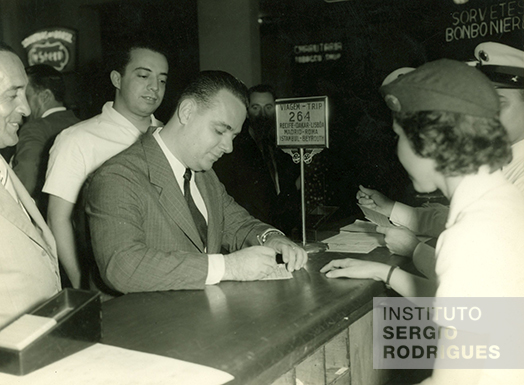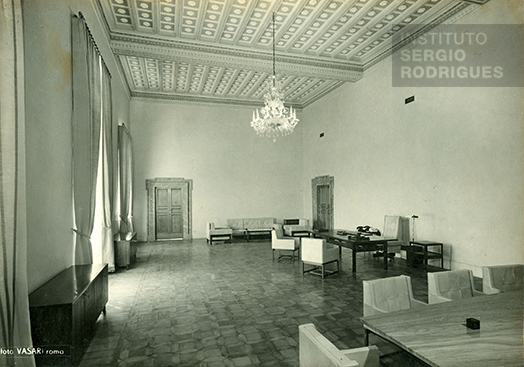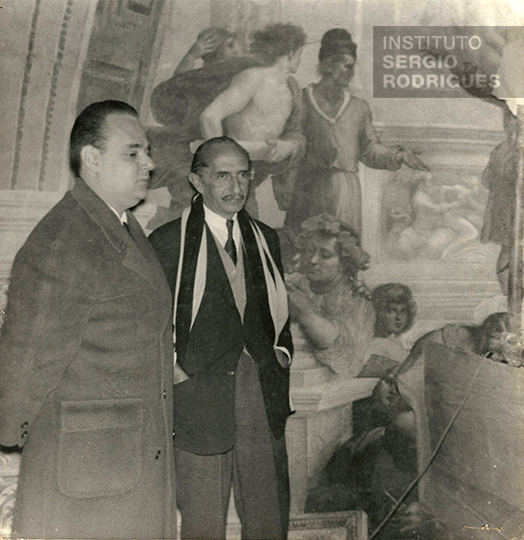"Whoever made this table will do the entire embassy in Rome." (Hugo Gouthier)
“Whoever made this table will do the entire embassy in Rome.” (Hugo Gouthier)
As often happens, Sergio’s recognition in Brazil increased after he started being praised abroad. Just before winning the award in Cantu, Italy, as said earlier, Italian magazine Domus published, in 1959, a report on Sergio’s work, an article signed by the famous Italian architect Gio Ponti. It was glory. Domus was a very prestigious magazine among Brazilian architects of the time, and it used to be said that those who did not know it had no right to call themselves architects or designers.
As years went by, his fame abroad grew in the form of publications and awards. Both the award and the praise abroad opened a path for Sergio to get government orders to shape the view people had on Brazilian furniture abroad. The most significant project was the 1959 invitation to do the entire interior decoration of Palazzo Pamphili, the Brazilian Embassy in Rome.
This invitation came after ambassador Hugo Gouthier, who served in Rome and came to Oca one day, saw Sergio’s furniture. He looked around and said: “Whoever made this table will do the entire embassy in Rome.” The Foreign Ministry then hired the author of the furniture. Sergio went to Italy alone and decided he could not take the furniture from here. He recalled that his former partner Carlo Hauner had a workshop in Italy. Sergio consulted him. He said he would make the drawings, but who could produce them? Hauner replied: “I will make the furniture in my factory in Italy.” No sooner said than done. He called the factory, which had a good stock of African Jacaranda, and there they made all of the embassy’s furniture.
Sergio spent a year working at the embassy in Rome. During this period, he often went to Milan, the temple of Italian design. Until one day, his partner Carlo Hauner, who was Italian and was there, invited him to meet Gio Ponti. They went over to his house and he was there. Sergio remembered this meeting well, as its outcome was the Domus publication.
“Gio Ponti welcomed me in a very friendly way. I found the way he treated interiors very interesting – because he was an interior architect as well -, but was not very fond of his furniture. Except for one piece or another. It is not that they were embellished. In fact, they had a touch of simplicity. His Superleggera was very fine, very light. It was a very beautiful thing. You could lift it with a finger. He became interested in my work and wanted to see it. I already had photos of my furniture with me. He was very interested, picked out five or six pieces, and published them in Domus. When it arrived in Brazil, it was a big hit, a very big boost.” Because of this episode, some time later Sergio renamed as Gio, in honor of Gio Ponti, an armchair he had created 1958, a year before the publication in the magazine.
At that time, Brazil was experiencing the cultural effervescence of bossa nova, of the New Cinema, the concreteness and abstraction in the visual arts and modernism in architecture. It was a modernization fever and Sergio came to represent, in creating his furniture, this modernity and effervescence. A new, cheerful, relaxed, informal Brazil appeared. Sergio Rodrigues’ style rolled out innovation based on tradition. It was a moment of great hope. “He was the designer of that hope, of a better Brazil, with joy, in which people were happy. I think he expresses this a lot,” said Adélia Borges.
When MoMA curator Paula Antonelli used the Tropical Modern expression to refer to designers known as the Campana Brothers, Adélia went further. She said the Campanas were already postmodern and the Modern Tropical expression is more fitting of Sergio’s profile and of those who came before, such as Tenreiro. To Adélia, the arrival of Sergio and of his deliberate search for Brazilianness resumed the tradition of the Iberian furniture.
Industrial production
Sergio’s first major job was an order placed to make the interior of the Legislative Assembly of São Paulo. Sergio recalls: “That was the first major order I got. Then I started to get desperate because we could not have it done elsewhere. I did not want to give the blueprints to others. And ended up doing it all myself. But I was always a little late. So we decided to do a more industrial thing. And the workers and masters we had were very capable. But since there were no orders to meet an industry, we controlled that. When there was a more serious order, in larger amounts, we delivered. The staff worked Saturdays, Sundays, if needed. But that only went to a certain extent, because later a little more complex orders started coming in. We were already at capacity. At first, we started off with a little factory, Queta, who had master Viana, who was wonderful. I realized the need to have something a little more complex to fill orders.”
The workers at Sergio’s factory were able to do business, but could not use special machinery for that yet. “We just braved it. The first factory was in Bonsucesso. The second we installed close to Avenida Brazil, at João Torquato. In 1965, we found a possibility, a large mattress company, that was filing for bankruptcy, in Jacareí, São Paulo. We went visit it. There were enough wood machines,
somewhat precarious, but sufficient. Many machines and looms. There were 40 looms to make fabric as well. It would not be our production, but it was always something interesting. I caught myself several times experimenting with fabrics. Mainly for Meia-Pataca. For the chairs and sofas themselves. But the fabrics were a little more rustic. So this factory, which covered an area of 10,000 square meters – it was very large – was adapted to be able to meet large orders and, in that case, the order placed by the Legislative Assembly of São Paulo. And a few things started coming in from Brasília.”

Sergio Rodrigues' boarding to undertake the interior architecture project for the Pamphilj Palace, Embassy of Brazil in Rome, Italy, in 1960.

Ambassador Hugo Gouthier's room at the Pamphilj Palace, Embassy of Brazil in Rome, Italy, in 1960.

Sergio Rodrigues with Lucio Costa at Stanze de Rafael, Vatican, Italy, 1960.
